Bright Blue, Green, and Red Luminescence from Dye-Sensitized Core@Shell Upconversion Nanophosphors under 800 nm Near-Infrared Light
Abstract
1. Introduction
2. Materials and Methods
3. Results and Discussion
3.1. Characterization of the IR-808 Dye
3.2. Characterization of Blue-, Green-, and Red-Emitting UCNPs
3.3. IR-808 Dye-Sensitized C@S UCNPs
4. Conclusions
Supplementary Materials
Author Contributions
Funding
Conflicts of Interest
References
- Hong, A.-R.; Kim, Y.; Lee, T.S.; Kim, S.; Lee, K.; Kim, G.; Jang, H.S. Intense Red-Emitting Upconversion Nanophosphors (800 nm-Driven) with a Core/Double-Shell Structure for Dual-Modal Upconversion Luminescence and Magnetic Resonance in Vivo Imaging Applications. ACS Appl. Mater. Interfaces 2018, 10, 12331–12340. [Google Scholar] [CrossRef] [PubMed]
- Cao, C.; Xue, M.; Zhu, X.; Yang, P.; Feng, W.; Li, F. Energy Transfer Highway in Nd3+-Sensitized Nanoparticles for Efficient near-Infrared Bioimaging. ACS Appl. Mater. Interfaces 2017, 9, 18540–18548. [Google Scholar] [CrossRef] [PubMed]
- Li, H.; Wang, X.; Huang, D.; Chen, G. Recent advances of lanthanide-doped upconversion nanoparticles for biological applications. Nanotechnology 2019, 31, 072001. [Google Scholar] [CrossRef] [PubMed]
- Wen, S.; Zhou, J.; Zheng, K.; Bednarkiewicz, A.; Liu, X.; Jin, D. Advances in highly doped upconversion nanoparticles. Nat. Commun. 2018, 9, 2415. [Google Scholar] [CrossRef]
- Wang, C.; Li, X.; Zhang, F. Bioapplications and biotechnologies of upconversion nanoparticle-based nanosensors. Analyst 2016, 141, 3601–3620. [Google Scholar] [CrossRef]
- Chen, Y.; D’Amario, C.; Gee, A.; Duong, H.T.; Shimoni, O.; Valenzuela, S.M. Dispersion stability and biocompatibility of four ligand-exchanged NaYF4: Yb, Er upconversion nanoparticles. Acta Biomater. 2020, 102, 384–393. [Google Scholar] [CrossRef]
- Deng, H.; Huang, S.; Xu, C. Intensely red-emitting luminescent upconversion nanoparticles for deep-tissue multimodal bioimaging. Talanta 2018, 184, 461–467. [Google Scholar] [CrossRef]
- Xue, Z.; Yi, Z.; Li, X.; Li, Y.; Jiang, M.; Liu, H.; Zeng, S. Upconversion optical/magnetic resonance imaging-guided small tumor detection and in vivo tri-modal bioimaging based on high-performance luminescent nanorods. Biomaterials 2017, 115, 90–103. [Google Scholar] [CrossRef]
- Shin, J.; Kim, Y.; Lee, J.; Kim, S.; Jang, H.S. Highly Bright and Photostable Li(Gd,Y)F4:Yb,Er/LiGdF4 Core/Shell Upconversion Nanophosphors for Bioimaging Applications. Part. Part. Syst. Charact. 2017, 34, 1600183. [Google Scholar] [CrossRef]
- Han, Y.; An, Y.; Jia, G.; Wang, X.; He, C.; Ding, Y.; Tang, Q. Facile assembly of upconversion nanoparticle-based micelles for active targeted dual-mode imaging in pancreatic cancer. J. Nanobiotechnol. 2018, 16, 7. [Google Scholar] [CrossRef]
- Wang, Y.-F.; Liu, G.-Y.; Sun, L.-D.; Xiao, J.-W.; Zhou, J.-C.; Yan, C.-H. Nd3+-Sensitized Upconversion Nanophosphors: Efficient In Vivo Bioimaging Probes with Minimized Heating Effect. ACS Nano 2013, 7, 7200–7206. [Google Scholar] [CrossRef] [PubMed]
- Xu, X.; Lei, P.; Dong, L.; Liu, X.; Su, Y.; Song, S.; Feng, J.; Zhang, H. Rational design of Nd3+-sensitized multifunctional nanoparticles with highly dominant red emission. Dalton Trans. 2016, 45, 8440–8446. [Google Scholar] [CrossRef] [PubMed]
- Wang, S.; Shen, B.; Wei, H.-L.; Liu, Z.; Chen, Z.; Zhang, Y.; Su, Y.; Zhang, J.-Z.; Wang, H.; Su, Q. Comparative investigation of the optical spectroscopic and thermal effect in Nd3+-doped nanoparticles. Nanoscale 2019, 11, 10220–10228. [Google Scholar] [CrossRef] [PubMed]
- Correales, Y.E.S.; Hazra, C.; Ullah, S.; Lima, L.R.; Ribeiro, S.J.L. Precisely tailored shell thickness and Ln3+ content to produce multicolor emission from Nd3+-sensitized Gd3+-based core/shell/shell UCNPs through bi-directional energy transfer. Nanoscale Adv. 2019, 1, 1936–1947. [Google Scholar] [CrossRef]
- Choi, J.E.; Kim, D.; Jang, H.S. Intense upconversion red emission from Gd-doped NaErF4:Tm-based core/shell/shell nanocrystals under 980 and 800 nm near infrared light excitations. Chem. Commun. 2019, 55, 2261–2264. [Google Scholar] [CrossRef] [PubMed]
- Arboleda, C.; He, S.; Stubelius, A.; Johnson, N.J.J.; Almutairi, A. High Nd(III)-Sensitizer Concentrations for 800 nm Wavelength Excitation Using Isotropic Core–Shell Upconversion Nanoparticles. Chem. Mater. 2019, 31, 3103–3110. [Google Scholar] [CrossRef]
- Guo, S.; Tsang, M.-K.; Lo, W.-S.; Hao, J.; Wong, W.-Y. 808 nm excited energy migration upconversion nanoparticles driven by a Nd3+–Trinity system with color-tunability and superior luminescence properties. Nanoscale 2018, 10, 2790–2803. [Google Scholar] [CrossRef]
- Wiesholler, L.M.; Frenzel, F.; Grauel, B.; Würth, C.; Resch-Genger, U.; Hirsch, T. Yb,Nd,Er-doped upconversion nanoparticles: 980 nm versus 808 nm excitation. Nanoscale 2019, 11, 13440–13449. [Google Scholar] [CrossRef]
- Hao, S.; Chen, G.; Yang, C.; Shao, W.; Wei, W.; Liu, Y.; Prasad, P.N. Nd3+-Sensitized multicolor upconversion luminescence from a sandwiched core/shell/shell nanostructure. Nanoscale 2017, 9, 10633–10638. [Google Scholar] [CrossRef]
- Zou, W.; Visser, C.; Maduro, J.A.; Pshenichnikov, M.S.; Hummelen, J.C. Broadband dye-sensitized upconversion of near-infrared light. Nat. Photon. 2012, 6, 560–564. [Google Scholar] [CrossRef]
- Yin, D.; Liu, Y.; Tang, J.; Zhao, F.; Chen, Z.; Zhang, T.; Zhang, X.; Chang, N.; Wu, C.; Chen, D.; et al. Huge enhancement of upconversion luminescence by broadband dye sensitization of core/shell nanocrystals. Dalton Trans. 2016, 45, 13392–13398. [Google Scholar] [CrossRef] [PubMed]
- Chen, G.; Damasco, J.; Qiu, H.; Shao, W.; Ohulchanskyy, T.Y.; Valiev, R.R.; Wu, X.; Han, G.; Wang, Y.; Yang, C.; et al. Energy-Cascaded Upconversion in an Organic Dye-Sensitized Core/Shell Fluoride Nanocrystal. Nano Lett. 2015, 15, 7400–7407. [Google Scholar] [CrossRef] [PubMed]
- Shao, Q.; Li, X.; Hua, P.; Zhang, G.; Dong, Y.; Jiang, J. Enhancing the upconversion luminescence and photothermal conversion properties of ∼800 nm excitable core/shell nanoparticles by dye molecule sensitization. J. Colloid Interface Sci. 2017, 486, 121–127. [Google Scholar] [CrossRef] [PubMed]
- Xue, B.; Wang, D.; Zhang, Y.; Zuo, J.; Chang, Y.; Tu, L.; Liu, X.; Yuan, Z.; Zhao, H.; Song, J.; et al. Regulating the color output and simultaneously enhancing the intensity of upconversion nanoparticles via a dye sensitization strategy. J. Mater. Chem. C 2019, 7, 8607–8615. [Google Scholar] [CrossRef]
- Xu, J.; Yang, P.; Sun, M.; Bi, H.; Liu, B.; Yang, D.; Gai, S.; He, F.; Lin, J. Highly Emissive Dye-Sensitized Upconversion Nanostructure for Dual-Photosensitizer Photodynamic Therapy and Bioimaging. ACS Nano 2017, 11, 4133–4144. [Google Scholar] [CrossRef]
- Park, J.; An, K.; Hwang, Y.; Park, J.-G.; Noh, H.-J.; Kim, J.-Y.; Park, J.-H.; Hwang, N.-M.; Hyeon, T. Ultra-large-scale syntheses of monodisperse nanocrystals. Nat. Mater. 2004, 3, 891–895. [Google Scholar] [CrossRef]
- Dong, A.; Ye, X.; Chen, J.; Kang, Y.; Gordon, T.; Kikkawa, J.M.; Murray, C.B. A Generalized Ligand-Exchange Strategy Enabling Sequential Surface Functionalization of Colloidal Nanocrystals. J. Am. Chem. Soc. 2011, 133, 998–1006. [Google Scholar] [CrossRef]
- Auzel, F. Upconversion and Anti-Stokes Processes with f and d Ions in Solids. Chem. Rev. 2004, 104, 139–174. [Google Scholar] [CrossRef]
- Dong, H.; Sun, L.-D.; Yan, C.-H. Energy transfer in lanthanide upconversion studies for extended optical applications. Chem. Soc. Rev. 2015, 44, 1608–1634. [Google Scholar] [CrossRef]
- Chen, G.; Shao, W.; Valiev, R.R.; Ohulchanskyy, T.Y.; He, G.S.; Ågren, H.; Prasad, P.N. Efficient Broadband Upconversion of Near-Infrared Light in Dye-Sensitized Core/Shell Nanocrystals. Adv. Opt. Mater. 2016, 4, 1760–1766. [Google Scholar] [CrossRef]
- Wang, X.; Valiev, R.R.; Ohulchanskyy, T.Y.; Ågren, H.; Yang, C.; Chen, G. Dye-sensitized lanthanide-doped upconversion nanoparticles. Chem. Soc. Rev. 2017, 46, 4150–4167. [Google Scholar] [CrossRef] [PubMed]
- Na, H.; Jeong, J.S.; Chang, H.J.; Kim, H.Y.; Woo, K.; Lim, K.; Mkhoyan, K.A.; Jang, H.S. Facile synthesis of intense green light emitting LiGdF4:Yb,Er-based upconversion bipyramidal nanocrystals and their polymer composites. Nanoscale 2014, 6, 7461–7468. [Google Scholar] [CrossRef] [PubMed]
- Choi, J.E.; Kim, H.-K.; Kim, Y.; Kim, G.; Lee, T.S.; Kim, S.; Kim, D.; Jang, H.S. 800 nm near-infrared light-excitable intense green-emitting Li(Gd,Y)F4:Yb,Er-based core/shell/shell upconversion nanophosphors for efficient liver cancer cell imaging. Mater. Des. 2020, 195, 108941. [Google Scholar] [CrossRef]
- Nsubuga, A.; Sgarzi, M.; Zarschler, K.; Kubeil, M.; Hübner, R.; Steudtner, R.; Graham, B.; Joshi, T.; Stephan, H. Facile preparation of multifunctionalisable ‘stealth’ upconverting nanoparticles for biomedical applications. Dalton Trans. 2018, 47, 8595–8604. [Google Scholar] [CrossRef]
- Xu, J.; Sun, M.; Kuang, Y.; Bi, H.; Liu, B.; Yang, D.; Lv, R.; Gai, S.; He, F.; Yang, P. Markedly enhanced up-conversion luminescence by combining IR-808 dye sensitization and core–shell–shell structures. Dalton Trans. 2017, 46, 1495–1501. [Google Scholar] [CrossRef]
- Wu, X.; Lee, H.; Bilsel, O.; Zhang, Y.; Li, Z.; Chen, T.; Liu, Y.; Duan, C.; Shen, J.; Punjabi, A.; et al. Tailoring dye-sensitized upconversion nanoparticle excitation bands towards excitation wavelength selective imaging. Nanoscale 2015, 7, 18424–18428. [Google Scholar] [CrossRef]
- Wang, W.; Zhao, M.; Wang, L.; Chen, H. Core-shell upconversion nanoparticles of type NaGdF4:Yb,Er@NaGdF4:Nd,Yb and sensitized with a NIR dye are a viable probe for luminescence determination of the fraction of water in organic solvents. Microchim. Acta 2019, 186, 630. [Google Scholar] [CrossRef]
- Shin, J.; Kyhm, J.-H.; Hong, A.-R.; Song, J.D.; Lee, K.; Ko, H.; Jang, H.S. Multicolor Tunable Upconversion Luminescence from Sensitized Seed-Mediated Grown LiGdF4:Yb,Tm-Based Core/Triple-Shell Nanophosphors for Transparent Displays. Chem. Mater. 2018, 30, 8457–8464. [Google Scholar] [CrossRef]
- Wang, F.; Han, Y.; Lim, C.S.; Lu, Y.; Wang, J.; Xu, J.; Chen, H.; Zhang, C.; Hong, M.; Liu, X. Simultaneous phase and size control of upconversion nanocrystals through lanthanide doping. Nature 2010, 463, 1061–1065. [Google Scholar] [CrossRef]
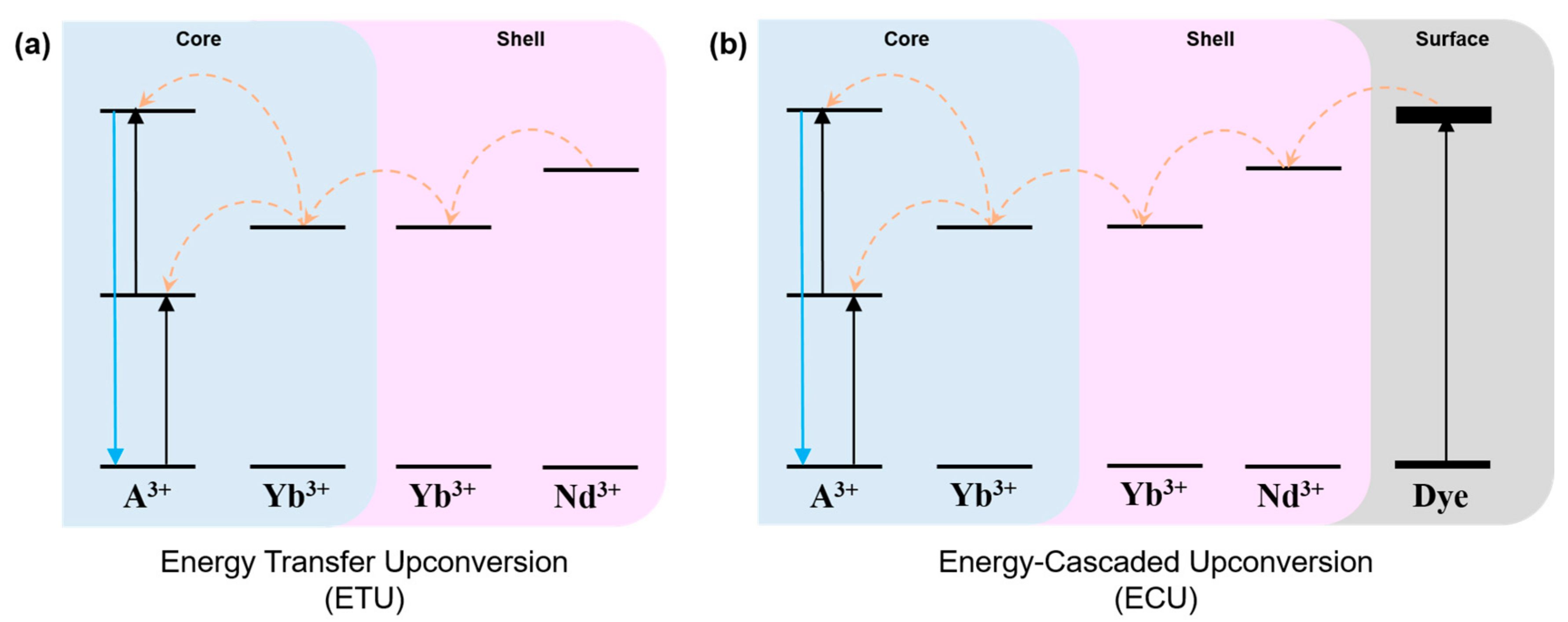

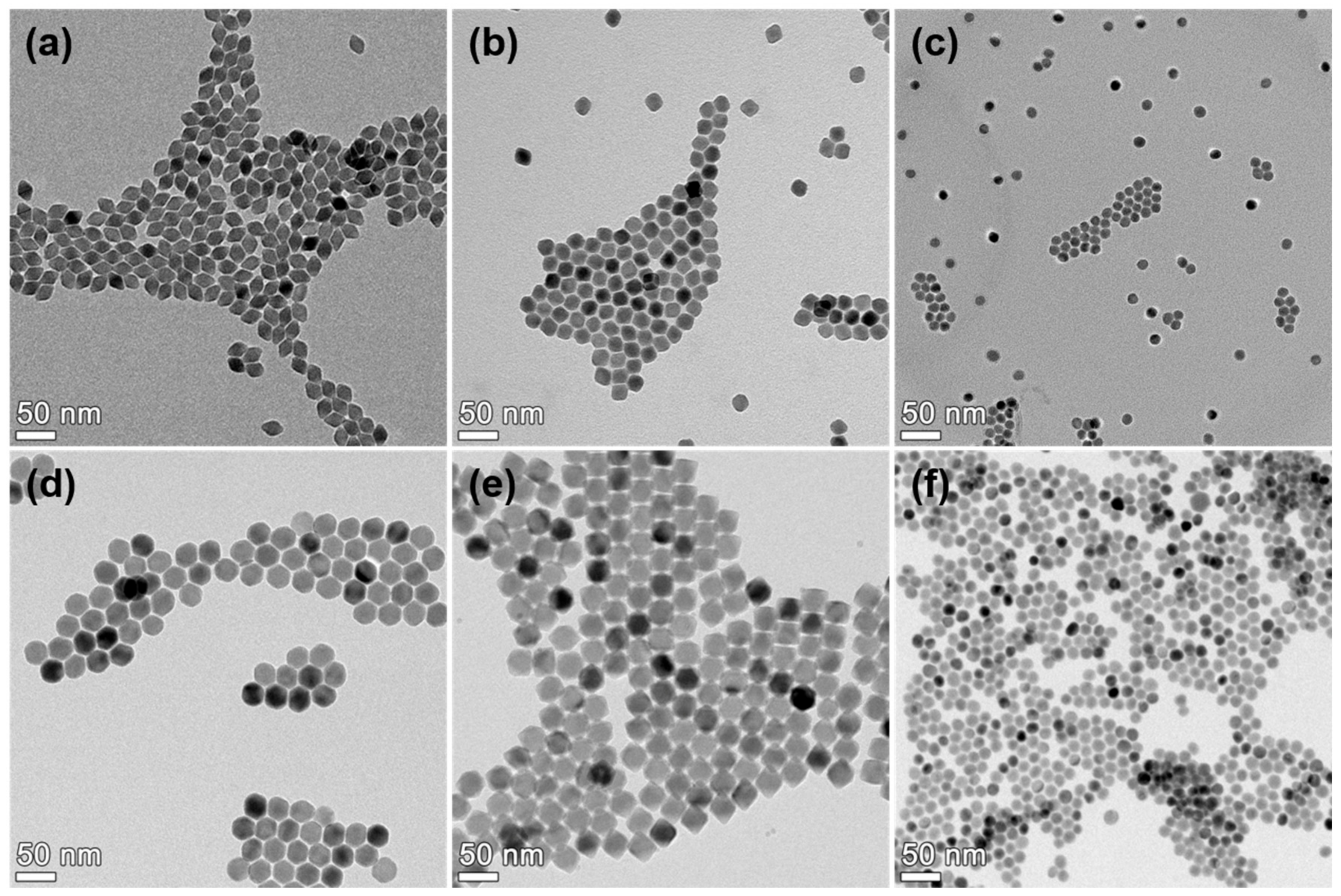
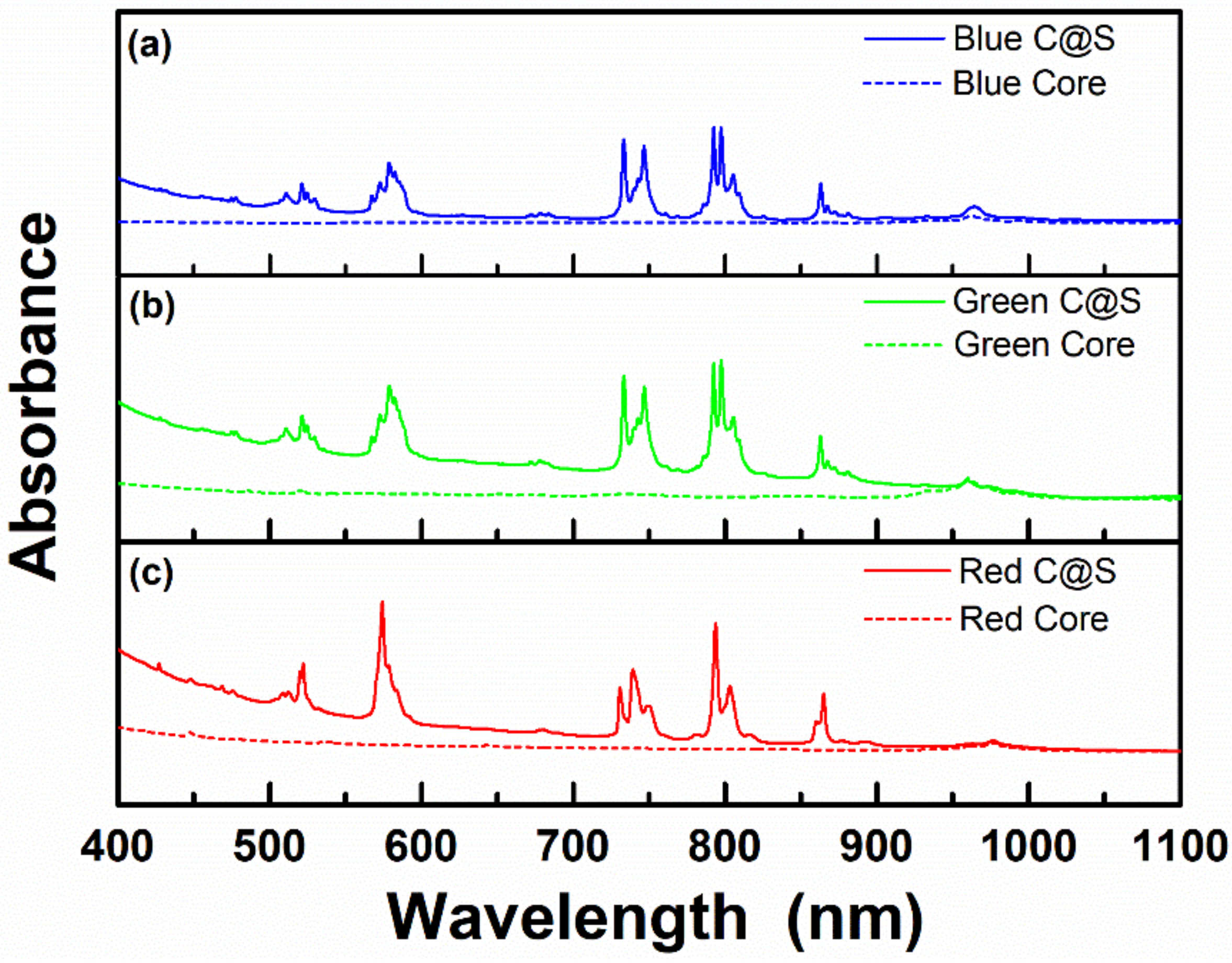
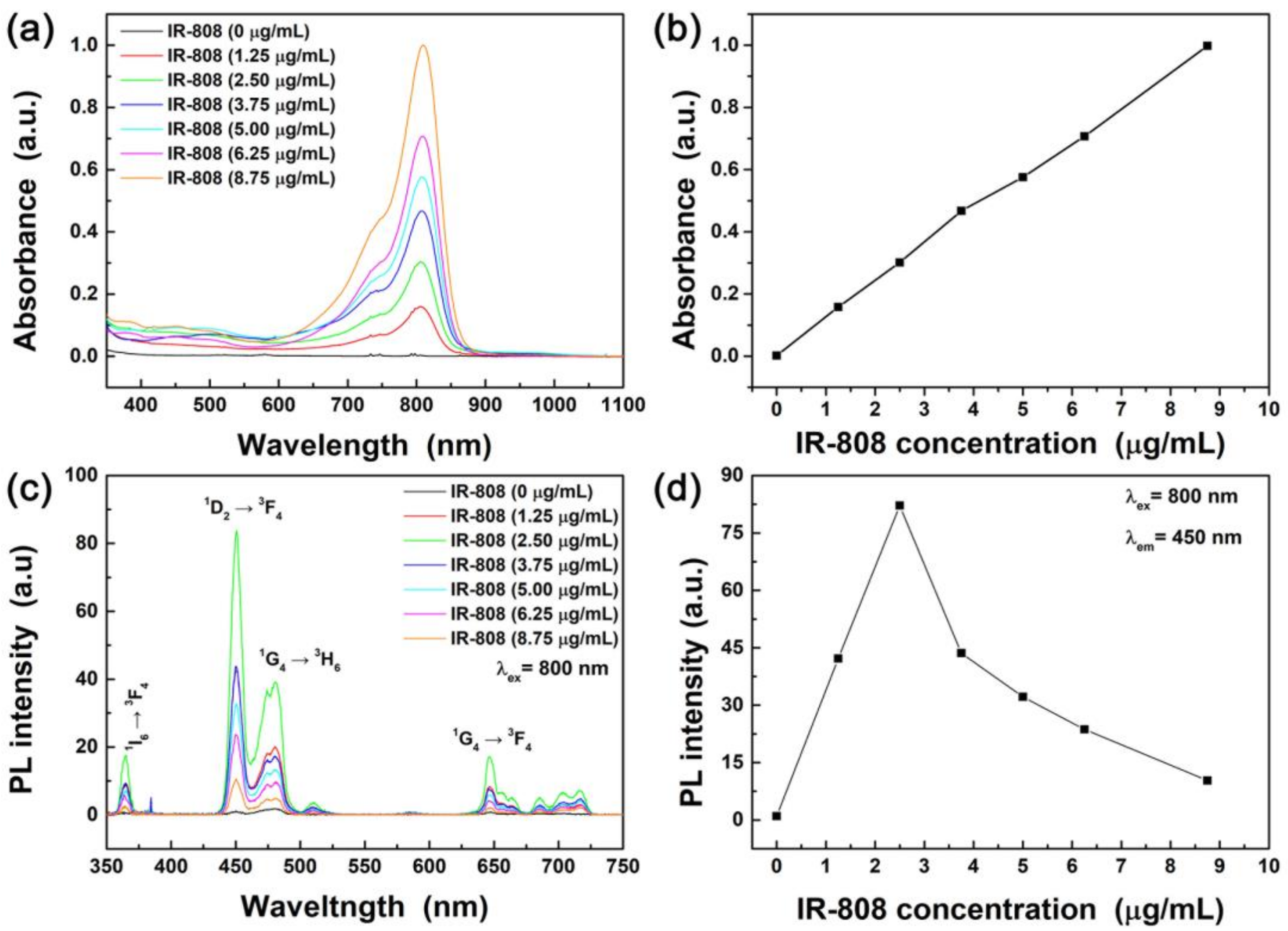
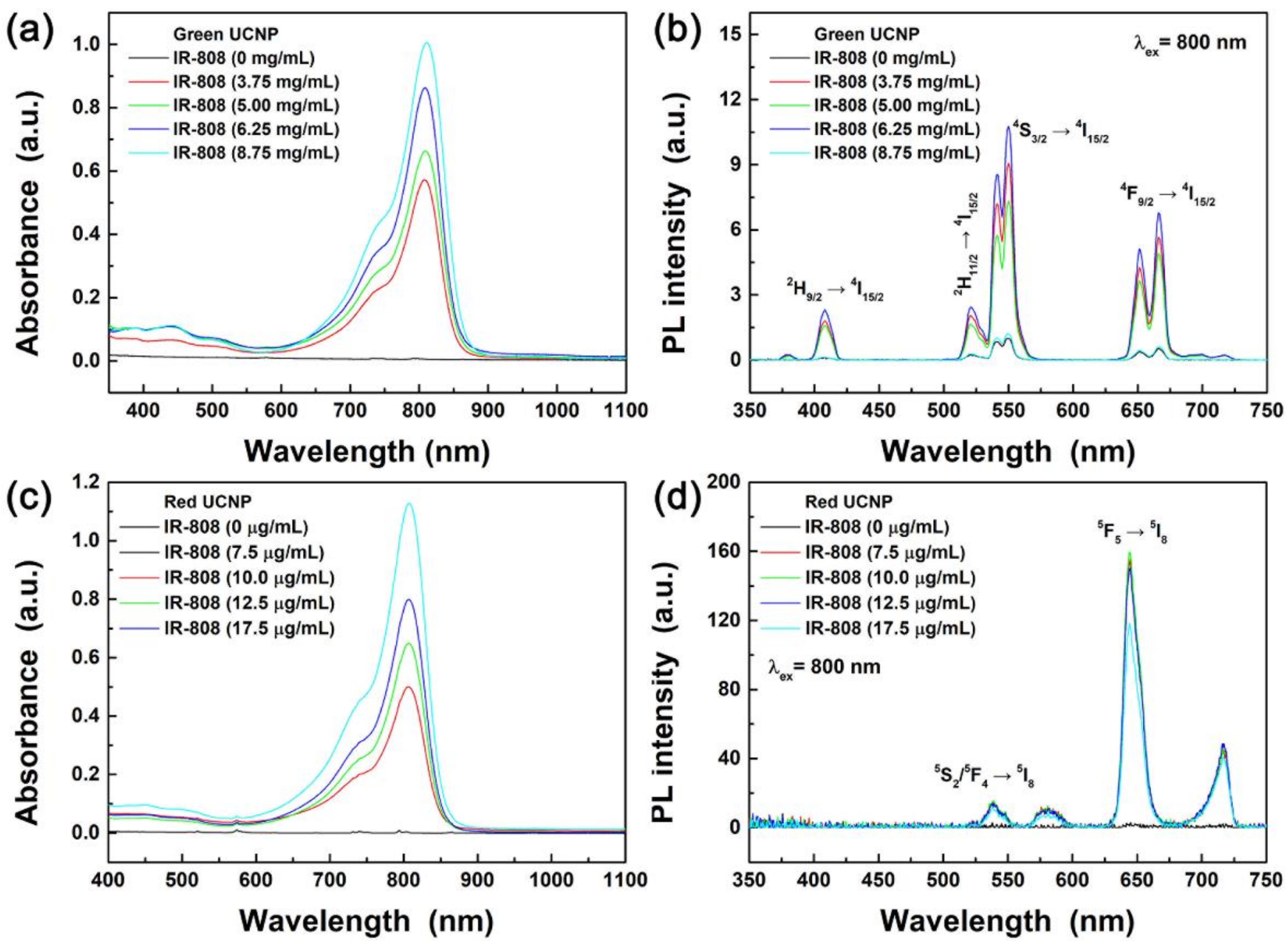
Publisher’s Note: MDPI stays neutral with regard to jurisdictional claims in published maps and institutional affiliations. |
© 2020 by the authors. Licensee MDPI, Basel, Switzerland. This article is an open access article distributed under the terms and conditions of the Creative Commons Attribution (CC BY) license (http://creativecommons.org/licenses/by/4.0/).
Share and Cite
Hong, A.-R.; Han, J.S.; Kang, G.; Ko, H.; Jang, H.S. Bright Blue, Green, and Red Luminescence from Dye-Sensitized Core@Shell Upconversion Nanophosphors under 800 nm Near-Infrared Light. Materials 2020, 13, 5338. https://doi.org/10.3390/ma13235338
Hong A-R, Han JS, Kang G, Ko H, Jang HS. Bright Blue, Green, and Red Luminescence from Dye-Sensitized Core@Shell Upconversion Nanophosphors under 800 nm Near-Infrared Light. Materials. 2020; 13(23):5338. https://doi.org/10.3390/ma13235338
Chicago/Turabian StyleHong, A-Ra, Joon Soo Han, Gumin Kang, Hyungduk Ko, and Ho Seong Jang. 2020. "Bright Blue, Green, and Red Luminescence from Dye-Sensitized Core@Shell Upconversion Nanophosphors under 800 nm Near-Infrared Light" Materials 13, no. 23: 5338. https://doi.org/10.3390/ma13235338
APA StyleHong, A.-R., Han, J. S., Kang, G., Ko, H., & Jang, H. S. (2020). Bright Blue, Green, and Red Luminescence from Dye-Sensitized Core@Shell Upconversion Nanophosphors under 800 nm Near-Infrared Light. Materials, 13(23), 5338. https://doi.org/10.3390/ma13235338



